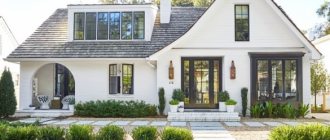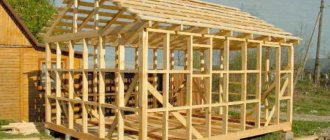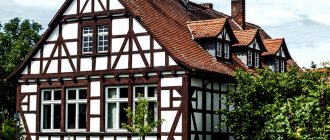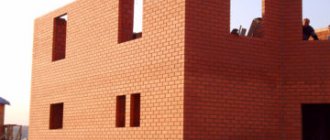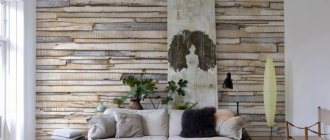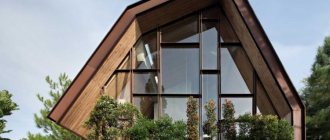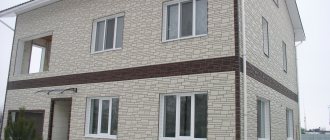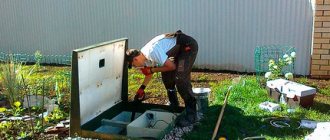Basic requirements of SNiP
The requirements for a building located on a garden plot are less stringent than for a residential building. However, if during the construction process you create discomfort for your neighbors, you may be forced to demolish the finished building.
Minimum distance from other buildings, fences and roadways
Therefore, before choosing a project, you should familiarize yourself with the basic requirements of SNiP:
- even on a small plot, the building can only be located at a distance of 3 m from the neighbor’s fence
- the minimum distance from public territory (road) is also 3 m, and if there is a passage 5 m
- if there are other buildings on your site, in order to reduce the risk of their fire, the distance between block or stone buildings is left at least 6 m, between a stone and a wooden building 10 m, if both buildings are wooden - 15 m; when using wood only as a ceiling - 8 m
- if there is a nearby power line, the distance from it is from 10 m; from the high-voltage line it is even greater, up to 40 m
- a certain distance (up to 4 m) must be retreated from tree trunks; 2 m is sufficient from low-growing trees.
Don't forget about building density. With standard dacha plot sizes of 6-10 acres, you have the right to occupy no more than 30% of the area with buildings.
The territory must have a mesh or lattice fence 1.5 m high. Solid fences are allowed only if this is agreed upon by the meeting of gardening members or both neighbors agree to this.
Do I need any permission?
According to Art. 51 clause 1 part 17 of the Civil Code of the Russian Federation, if the building is not intended for permanent residence, no special construction permit is required. But to obtain ownership rights to an already built garden house, as well as to other outbuildings, you will need to issue a cadastral passport and register with the Registration Chamber (according to a simplified scheme).
If a building already built on the site has not yet been registered, it is worth taking advantage of the dacha amnesty and completing all the missing documents
If it is planned to erect a residential building on a garden plot with the right to register in it, then it will be necessary to obtain a special permit signed by the executive authorities and a construction passport. As well as permission from the fire inspectorate. In the future, registration of ownership of the building will also be required.
Important Tips
Even a small building should last long enough
To make your country house as comfortable as possible, you should listen to the opinions of experts:
- No matter how much you would like to build something unusual on your site, with little construction experience it is better to settle on a universal project that has already been tested over the years
- when planning, you should immediately determine the size of the rooms and their location; this will allow you to immediately determine the supply of communications (sewage and water supply), which are laid at the stage of building the foundation
- In order to save your own money, the design of even a temporary building must be thought out so that in the future it can be used as a bathhouse, barn or summer kitchen
- be sure to take into account the possibility of further adding additional premises to the building: verandas, terraces, bathhouses and other buildings
- even in a small house it is worth providing not only a relaxation room, but also a kitchen area
- in the absence of other buildings, a separate place should be allocated for placing garden tools
- the building must be durable enough to last at least 25-30 years
Photos of the best country houses made of wood
Initially, most people preferred wood. In addition, this material will definitely never lose its relevance. After all, it is natural, and therefore environmentally friendly. Today, most of these buildings are beautiful small country houses made of wood, a photo selection of which you can see on our website.
Their advantages:
- Not too high prices for the material.
- Construction will not last very long.
- The foundation can be erected using a pile-screw type, and on any soil.
- Wood provides peace and tranquility inside the home.
- Excellent thermal insulation properties.
- In winter, it can be heated very quickly to keep it warm.
- You can build a house of any size and shape into reality.
- The material is environmentally friendly for everyone.
- The tree has the function of self-regulating humidity levels.
Disadvantages of the material:
- High degree of fire hazard.
- Possible fungus formation and rotting.
A wooden house is an excellent option for relaxation at any time of the year, especially if you come to your summer cottage for just a couple of days.
How much will construction cost?
Approximate sample estimate
Regardless of the size of the future garden house, before starting construction you will need to calculate the cost of its construction. To do this you need to think about:
- main parameters : length, width and height of the building
- type of foundation and its height
- the type of materials used to construct the walls and their thickness
- roof type
- materials used for flooring
- dimensions of each room
- heating methods (if planned)
- types of finishing materials
- methods of connecting communications: electricity, sewerage, etc.
There are enough programs on the Internet that can calculate the approximate cost of construction of any type of building. Most of them have a free trial period. You can also use online calculators for calculations. Please note that the cost of materials may differ from those in your region of residence.
Since prices may rise during the construction of a country house, if the construction is planned for a long time, it is better to include a reserve of at least 10-20% of the total cost in the estimate. When calculating the cost, do not forget that such “little things” as roofing bolts, screws, primer, and plaster will also require considerable expenses.
It is better to purchase materials in one place - bulk purchases will be much cheaper.
Types of bricks and their purpose
For the construction of small country houses, brick is one of the most ideal options. Firstly, it is compact, which means that in small quantities it can even be transported in a trailer to a car, which will allow you to save a little on construction. Secondly, its installation can be carried out gradually without loss of quality. In addition, bricklaying does not require special knowledge and skills, so anyone can learn it. Based on this, you can build a brick cottage yourself, saving money.
All brick can be divided into two categories:
- private,
- facing.
Ordinary brick is used for the construction of walls and interior partitions. It is distinguished by its strength and temperature resistance. There are no high demands placed on this material regarding the evenness of the surface or the straightness of the corners, because after installation the ordinary brick will be hidden under a layer of lining or facing frame.
Facing bricks are intended for finishing external walls built from a different material. He is not as strong as a private. But according to GOST it must have a flat surface and correct angles.
By size, bricks are divided into:
- single,
- one and a half.
The latter type of material is preferable for construction, because it significantly saves mortar.
According to GOST, bricks are divided into grades based on strength. The most popular of them for the construction of low-rise buildings are M-100 and M-125. The numbers in the marking indicate the load that the material can withstand in kilograms per square centimeter. Another parameter used in the labeling is frost resistance. Thus, a brick marked F-50 can withstand up to fifty cycles of sudden temperature changes, and a brick marked F-75 can withstand up to seventy-five. For our latitudes, the last option is best.
Depending on the structure, bricks are divided into:
- Full-bodied. Better suited for the construction of foundations and load-bearing structures.
- Hollow. Perfect for wall cladding. Due to the voids in the middle, such a brick perfectly maintains the temperature inside the room.
Currently, the dimensions and structure of the material may vary. Thus, large bricks have already appeared on the market, which are similar in size to cinder blocks, as well as porous ones, during the production of which wood shavings are added to the solution. It burns out during firing, leaving behind voids.
Choosing a location on the site
Choosing the optimal location on the site
First you need to draw up a scale plan of the estate and mark the cardinal directions on it. We immediately mark on it existing buildings and large plants that are not subject to demolition. We shade all restricted areas on the plan (distances from the fence, power lines, etc.).
You should also not locate the building near compost pits and toilets - with the slightest breeze, unpleasant odors will enter the house. We mark favorable zones in dotted lines. Try to plan the site in such a way that even after construction there will be space for outbuildings (if they are needed), recreation areas, for example, a swimming pool, gazebos, playgrounds, etc.
In addition to the distances from neighboring buildings and roads established by SNiP, you should also focus on other factors:
- It is better to locate a country house closer to access roads and sources of communications: loading and unloading crops and household items will not be a big problem in this case, and connecting to power supply and other communications will be cheaper
- wind direction: to prevent the building from drying out quickly, you should not place windows and doors on the side of the prevailing winds
- When the windows face south or east, the room will quickly overheat in the summer; it is better if the sun hits them in the afternoon
- so that groundwater does not destroy the foundation of the building, the house is located on the most elevated place; on wetlands, if there is no alternative, you will need to consider a reliable drainage system and waterproofing the foundation
- Pay attention to the appearance from the window, because comfort always comes from such little things.
Take your time choosing a project. Start development at least six months before the start of construction so that you have the opportunity to think it through thoroughly and make calculations without rushing.
What are the benefits of brick houses?
Advantages of brick houses:
- durable;
- durable;
- frost-resistant;
- environmentally friendly;
- universal for design, it is possible to create a house in any style;
- fireproof;
- maintain natural regulation of humidity in the house;
- resistant to external factors: sun, rain, winds, etc.;
- the walls do not rot, are not destroyed by insects and rodents;
- do not lose their attractive appearance for a long time;
- have a high level of sound insulation;
- they create a favorable microclimate. They are not hot in summer and not cold in winter.
Disadvantages of brick houses:
- building a house from high-quality brick will be expensive;
- long construction period;
- require additional interior finishing;
- additional insulation is necessary, since the cement mortar holding the bricks together has high thermal conductivity;
- heavy construction, requires a strong foundation;
- High hygroscopicity, drying takes a long time.
- You should pay close attention to the quality of the material, as it may contain increased radioactivity; it is better to buy bricks from large, trusted suppliers.
It is recommended to build brick houses for year-round use. Lack of heating in winter can negatively affect their strength.
It must be taken into account that the strength and durability of the building depends on the characteristics of the material used, the brand of mortar, the quality and correctness of the masonry work.
We are drawing up a project
Of course, the design of a country house can be ordered from a specialized organization, but the prices for such services are considerable. When building a small house, it is much easier to use ready-made diagrams, which are abundant on the Internet, and supplement them with your own calculations.
Building plan
You will need several drawings. The first one indicates the location of all rooms, entrances and window openings, as well as the thickness of walls and partitions. The second figure shows the layout of the foundation and the roofing scheme.
In the third diagram, it is necessary to calculate the location of the roof rafters and foundation blocks with their height indicated. A separate plan is drawn up for sewerage, water supply, heating and ventilation systems.
Small building project
It is not practical to build a structure that is too large on 3-6 acres of land - it will take up most of the site. A grandiose structure is not required even if you spend little time at the dacha. In some cases, a small building without a foundation and assembled from boards or even plywood is sufficient. However, such a house will not last long.
Small building with an open terrace
Inexpensive panel or foam block buildings on a pile foundation will cost a minimal amount and will even go to your grandchildren. A small country house can have a standard size of 3x3 or 4x4 m, and it will even be possible to provide a separate small walk-through kitchen-dining room. The second room will have one or two sleeping places.
A small house may have only one room with space for kitchen cabinets, a dining table and a sleeping area. But even for a small country house, it makes sense to attach a winter glazed veranda or terrace along the long side of the building, 2 m long. The veranda is built on a common foundation or the foundation for it is poured separately.
A separate columnar base is being prepared for the terrace. With a minimum budget, a country house building can be made with a pitched roof - the cost of such a roof is minimal. However, it should be noted that the angle of inclination of the roof is calculated taking into account the height of the snow cover.
When determining the total area of the premises, it is necessary to take into account the thickness of the walls.
Medium sized house
Structures measuring 6x4 and 5x6 m are the most popular. They provide not only a kitchen-dining room and a bedroom, but also a shower room and a bathroom. To save space, a corridor with a small dressing room can be divided not by a wall, but only by a small arch.
Such country houses have a foundation and heating. On the façade side they are finished with thermal insulation materials. You can even place a medium-sized country house on 5-6 acres - there will be room for garden beds, a swimming pool or a small pond and a flower garden.
Medium sized house layout
Such a house can be made with a summer or winter attic. A medium-sized building will occupy a minimum of free space on the land plot, while the living area will increase. If there is an attic, bedrooms are located in it, and on the ground floor there is a kitchen and a bathroom.
It is better to complement such a building with a veranda or terrace, where you can comfortably settle down to relax in the evening. For better heat retention, a vestibule can be provided in front of the entrance . A small summer shower will fit perfectly on the veranda.
If lightweight timber is used to build walls, and there are no problems with the soil (it is not too wet or loose, and groundwater does not rise too high), it is sufficient to erect a strip foundation. The foundation for the stove is prepared simultaneously with the foundation of the house. For a veranda, a columnar base will be sufficient.
For a log house made of 150x150 timber, a strip of foundation 25 cm wide is prepared. The terrace is installed separately on pillars with a cross-section of 25 cm, buried in the ground at a distance of 60 cm. When building in marshy areas or erecting brick walls, you will need a full-fledged deeply buried foundation.
To save money, the foundation for the veranda can be made as a separate lightweight foundation (column or pile). It can be added after construction is completed. But the option with a separate foundation is suitable only if there is soil that is not prone to movement, otherwise the foundation will move.
Large house project
If the family is large and the country house is planned to be used as a residential one, including in winter, it makes sense to build a permanent building from rounded logs, timber or even brick according to ready-made designs measuring 5.3x8.4 m, 7x8.4 m, 10x8 m and more. You can also order the development of your own non-standard project.
Building design 9.09x3.590 m
Such houses require a full strip foundation. It is laid below the freezing point of the soil, so that when seasonal temperatures change, movement and deformation of the structure does not occur.
A large country house can be two-story or consist of one floor and an insulated attic. It will have enough space not only for residents, but also for guests. On the ground floor there is a kitchen, bathroom and living room, and on the second floor there are bedrooms, children's rooms, an office and other rooms if necessary.
Building layout 5.8x7.6 m
To avoid unnecessary problems with the supply of water, gas and sewerage, it is not worth moving the bathroom and cooking room to the second floor. It is also customary to arrange the living room on the ground floor, near the kitchen and away from the bedrooms.
If the building is planned to be used all year round, it is better to build not an attic, but a full second floor . Otherwise, almost the same amount of money will be spent on its insulation, wind and vapor barrier as on the construction of the second floor. It is also necessary to take into account heating costs - in the winter cold, solid walls will store heat much better than even well-insulated thin attic walls.
House with an attic
A country house with an attic will cost less than the construction of a full-fledged two-story building only if it will be used only in the summer. But even when arranging it you will need insulation. Otherwise, on sunny days it will be too hot. The heat insulation layer is made slightly thinner than for winter use.
If only the first floor is heated, only the walls of the building and the ceiling are insulated, leaving the attic cold. The door/lid intended for access to the upper floor is made as tight as possible and additionally insulated.
Layout of a house with an attic
When constructing a conventional gable roof, the living space in the attic will not be enough. To increase the free space, the roof is made broken. However, its construction is more complex, and more materials will be required.
Another way to expand the space in the attic is to raise the walls just above the first floor. Such houses are called “one-and-a-half story houses.” By raising the walls, the area of the premises will increase slightly.
Project of a house with a glazed veranda
The veranda can be attached to only one side of the house or run along two or even three walls. On heaving soils, it is better to build the foundation for it simultaneously with the foundation of the house. After all, when making a separate shallow foundation, you will gain only 1-2 m.
Glazed veranda with completely open lower part
Most often, the veranda is completely glazed or the lower half of the wall is covered, and double-glazed windows or single frames are inserted along the top. You will receive a full-fledged room in which you can equip a dining room, living room or kitchen. In the warm season, the windows can be opened wide.
The veranda can also serve as a continuation of the living room. It can also be equipped with a small sports corner, a children's playroom or even an office.
House with terrace
On the covered terrace you can not only sit down for tea on a warm summer evening. On hot or rainy days, you can use it to do some current chores without littering the house. Often it is built upon completion of the main construction on a separate columnar foundation.
A small building 6x6 m with a terrace consists of a kitchen and 2 rooms
A terrace, unlike a veranda, is always built on a separate columnar or pile foundation with a wooden deck laid on it, which rises slightly above the ground. The roofing for it is also most often done separately. Such structures are always open.
You can only provide for the presence of a mosquito net. The terrace is located mainly on the entrance side - in this case it also serves as a porch. Its length most often coincides with the width of the structure itself.
Building with garage
A country house can be combined with a garage. In this case, you will be able to significantly save space on your site. The main disadvantage of such a building is the penetration of gasoline odors into the house. Therefore, before placing the door to enter the garage in the hallway or glassed-in veranda, this point is worth considering.
Country house with garage
The garage is built as an extension to the house or is located on the ground floor. The walls and foundation can be made of brick or concrete blocks. If the soil is wet or loose, the house is installed on a reinforced concrete pad.
Two-storey house
If the family is large enough, and the size of the plot does not allow building a large country house, it makes sense to build a two-story building . In this case, you will be able to squeeze the maximum benefit out of even a small piece of land. The size of such a structure can be any from 4x4 m to 10x10 m or more.
Project of a two-story building
The construction of a second floor will not cost much more. The load on the foundation increases by only 60%. Costs for flooring and roofing do not increase at all. Only the cost of materials for walls and floor coverings will be added. Thus, a square meter of area will cost less than in the case of a one-story building.
Experts do not advise overloading houses made of timber with an additional floor. It has enough advantages, but its strength has limits.
Country house combined with a bathhouse or sauna
If the land plot does not allow you to allocate a separate place for the construction of a bathhouse, it is quite possible to attach it to a country house. Such a project is also economically beneficial - after all, much more building materials will be needed for a separate building. There will be no need for separate communications - light and water supply.
Very often, a bathhouse or sauna is added to a house after construction is completed. The foundation for it is selected depending on the type of soil and the total weight of the building. To protect against moisture, the walls are carefully waterproofed.
Even if the bathhouse is being built simultaneously with a residential building, the foundation for it is made separate so that due to the difference in humidity, cracks do not appear and it does not move away from the general structure. The foundation must be built separately from the foundation of the house.
House combined with a sauna
Indeed, due to high humidity, cracks may appear in it, and the base of the bathhouse will begin to move away from the foundation of the entire structure. Sewer and water supply pipes are laid in it. A separate drainage pit is prepared at a distance of at least 3-5 m from the foundation.
To prevent moisture from entering the room, the entrances to the bathhouse or sauna and the house are made separate. Between them you can build a covered corridor-transition, a veranda, a gazebo, or at least a canopy - in this case, when moving from the bathhouse to the house in winter, the likelihood of catching a cold is reduced. Since baths and saunas are a source of high humidity, you should carefully consider the ventilation system and waterproofing of the room.
In addition to ventilation holes, it is advisable to provide a window or small window for ventilation. The most acceptable option is to connect the steam room to a wall with a stove located in the house. In this case, the bathhouse or sauna will dry out much faster.
House with bay window
A bay window is a small part of a room protruding beyond the facade. Such structures will look ridiculous against the background of a building of a regular shape. A bay window will look harmonious only if there is a complex architecture, an unusual shape of windows, a roof or an entrance lobby.
It can be built into only one of the floors or pass through two floors at once. The bay window can have any shape: from semicircular to trapezoidal or pentagonal. With its help, it is possible to expand the area of the building - in such extensions there are dining areas, winter gardens or work rooms.
Building with bay window
In the absence of experience in construction, it is hardly possible to create such a structure, and the project will need to be ordered from specialists. However, such a house looks very unusual.
It is possible to add a bay window after the construction of the country house . In this case, cantilever slabs are used as the foundation, which are built into the load-bearing wall. Such a foundation is buried to the same level as the foundation of the entire house. To lay out shaped protrusions, brick or profiled timber with a special locking system is most often used.
The protruding elements of the bay window lead to a weakening of the rigidity of the entire structure, so the frame of the house must be strengthened.
What can you make from a whole brick at your dacha with your own hands?
A number of structures simply will not be able to fully perform their functions if they are assembled from damaged material. We will tell you about them first, and in the meantime, you slowly begin to select whole bricks from the mountain that you previously piled under the canopy.
Brick grill
This design is perhaps the most popular of all brick ones, since it performs not so much a useful as a pleasant function. More familiar to the average person, of course, is a metal grill, but if desired, it is quite possible to replace it with brick.
The easiest and fastest option for a barbecue is to lay out a square or rectangle of bricks in the place where you usually “indulge” in barbecue. The bricks are laid on top of each other in several rows. That’s it – the “mobile” grill is ready. Now go marinate the meat.
By the way, using the same principle, you can create a barbecue or tandoor at your dacha with your own hands.
If you want to create a barbecue that will serve you for more than one day, then in this case you need to install a solid foundation and reinforce the walls of the structure with metal mesh.
- Grill, oven, barbecue – what to choose for cooking in the country
We bring to your attention a brief overview of the main devices for cooking in the country.
Brick oven
This, of course, is not a barbecue for you; making a stove is much more difficult than his. But for a purposeful person there are no obstacles. As they say, you just need to want it. You can build a stove in a country house or in a bathhouse, equip it with a closed gazebo, construct a summer stove, or go even further and assemble a stove for burning garbage.
- How to make a stove for burning garbage at your dacha with your own hands
By law, it is prohibited to light open fires in summer cottages. How to burn plant residues if there is no other disposal option?
Brick toilet
Do you have so much brick left that it will be enough for a separate small building or extension? Build a toilet out of it. Brick construction is much stronger than wood because it is less susceptible to weather conditions. And even if your country house already has amenities, an outdoor toilet may well become a backup option. Especially if you have a lot of free time and you have nowhere to put the brick. By the way, getting rid of an unpleasant smell in a country toilet is not as difficult as it might seem at first glance.
- 5 proven ways to get rid of odor in a country toilet
We solve the problem of eliminating odor in an outdoor toilet.
Brick fireplace
Have you already built a toilet, but still don’t run out of bricks? Try to get by with a simplified version of the stove - a fireplace. Less work, but more aesthetics. A working fireplace will be especially pleasing to the eye on a rainy day, when you are not physically able to carry out garden work. It is only important to choose the right firewood for the fireplace.
- Choosing firewood for the stove, bathhouse and fireplace
They burn, but don't heat up. They burn and smoke and clog the chimney with soot. They flare up quickly, but they spark and shoot... All these are the consequences of the wrong choice of firewood.
Fireplace made of brick
This is essentially the same fireplace, but only in the yard. The simplest option for a fire pit is to place the bricks in a circle on a solid tile base and secure them with two wire rings. But, depending on the degree of your imagination, the design can be complicated.
Place the structure in such a place that the fire does not accidentally spread beyond the brick ring.
- 10 innovative ideas on how to make a fire pit in your country house with your own hands
A well-appointed fireplace in the country is not just a stylish element of the patio, but also the most comfortable place here. You understand this when autumn comes.
Fence posts
If the dacha has already been built, but there is still no strong fence, then the brick left over from the construction can be used for pillars to it. True, in this case it is better to resort to the help of specialists. But if you are confident in your own abilities, then it won’t hurt you to know a few secrets.
- A fence made of brick and corrugated board: how to make it yourself quickly and inexpensively
Learn about the intricacies of constructing a practical fence for a suburban area.
In addition to fence posts, you can also make bench supports in the form of small posts from bricks.
How much will it cost to purchase a finished building?
If you have no experience in construction, it makes sense to purchase a ready-made turnkey building. Depending on the allocated amount, you can buy either a simple panel structure or a full-fledged structure made of timber or logs. Since the cost of materials in each region may vary, it is better to find out the prices for such houses on the relevant websites.
Sample estimate for building a house
- For example, a small house made of 3x3 m timber with clapboard cladding will cost 60 thousand rubles.
- An average-sized building of 5x3 m will cost about 10 thousand rubles.
- A full-fledged log house with a veranda can be purchased for 270 thousand rubles.
Features of construction
Depending on the type of soil, a strong concrete slab is laid for the foundation or a strip foundation is made. Then they begin to build brick walls. It is important during construction to follow the order of the masonry. Building materials on the market allow you to build walls with 1.5-2 bricks, which significantly reduces the load on the foundation.
Two types of floors are used - prefabricated and monolithic, which allow you to implement design solutions for planning the interior space of the house and create a unique appearance of the home. Construction ends with roofing work. After the construction of the cottage, they are engaged in finishing the premises and decorating the garden area.
Materials used for construction
Types of foundations
The choice of foundation type depends on the type of soil and the total weight of the structure:
- columnar or pile foundations made of concrete blocks, bricks, reinforced concrete, rubble stone in increments of 1-2.5 m; to combine them into one structure that serves as the support of the house, a grillage made of wood or metal is used; the most economical option, more suitable for light timber or frame buildings, log houses; in country construction, screw piles are mainly used; driven, driven and drilled piles are used less frequently;
- strip foundation: a stronger support made of reinforced concrete, brick or rubble, such a strip runs along the entire perimeter of the house and internal partitions; is divided into two types: shallowly buried in the ground at 40-70 cm and deeply buried (used for heaving soils) 1.5-1.8 m below the freezing level; strip bases can be used for any type of house from cast, block to brick;
- slab base in the form of a monolithic reinforced slab located on a sand and gravel bed; when the soil heaves, such a foundation is capable of lowering and rising without any deformation; such a base simultaneously serves as a subfloor; Suitable for all types of buildings, including large ones.
A columnar foundation on loose soils or with close groundwater passage is unacceptable. In these cases, strip foundations are used.
Most types of foundations are built on a 20-30 cm sand and gravel cushion, which protects the foundation from groundwater and capillary moisture. It is especially important in the presence of heaving (peaty and clayey) soil, which, when frozen, changes its volume and rises to the top. In the absence of a sand and gravel substrate, this can lead to warping of the foundation and cracking of the walls.
Types of foundations
This cushion also helps to perfectly level the base before pouring the foundation. With its help, the pressure of the building on the ground is distributed more evenly. If it is absent and the structure settles unevenly, it may simply warp. Such a pillow is not made only on sandy soils or very wetlands.
When laying the foundation, sewerage and water supply pipes are immediately laid. Their depth is 0.5 m below the freezing point of the soil. If this is not possible, the pipes are additionally insulated. To ensure gravity flow of liquid, they are laid at a slight inclination of 4-7°.
Wall materials
Thermal insulation of different types of materials
The choice of materials for the walls of a country house depends on many factors: personal preferences, region of construction, duration of residence (all year round or only in the summer), project requirements and, of course, the allocated amount:
- frame or panel buildings : their main advantages are low cost and ease of construction; The disadvantages include high flammability, low wind resistance and poor thermal insulation - a few years after the shrinkage of mineral wool or polystyrene foam laid between the frame posts, it will be difficult to heat the house; service life 30-40 years;
- slag-cast : inexpensive buildings, for arranging the walls, formwork is prepared into which a mixture of cement and coal slag is poured; this method was even used in the construction of residential buildings several decades ago; the main disadvantage of this material is its low moisture resistance: inside such rooms, due to dampness, fungus quickly grows; service life up to 50-70 years;
- lightweight houses made of gas or foam blocks : these inexpensive materials are 8 times larger than ordinary bricks, so the construction of the building will be quick, in addition, the blocks are easy to saw or drill; due to their high porosity they have high heat and sound insulation; the service life of aerated concrete is up to 50-80 years, foam blocks are slightly lower;
- sandwich panel houses : unlike frame and panel houses, the strength element in them is not the racks and crossbars, but the panel itself, filled with polyurethane foam, polystyrene foam or mineral wool. Such structures do not require assembly - fragments of the future building are delivered ready-made, all that remains is to assemble them; although such products are more expensive than panel and frame products, the disadvantages are the same - high flammability and short service life; although manufacturers claim that such a house can last up to a hundred years, in practice, within a couple of decades after the insulation shrinks, it will be problematic to live in the house permanently;
- houses made of timber or log cabins : durable, environmentally friendly building; excellent heat retention; service life 100 years or more; garden houses made of timber can be purchased ready-made, “turnkey”;
- brick or stone buildings : their construction will cost much more, but they will also last 100-150 years or more.
Roof
For an inexpensive country house, it would be optimal to use a roof made of metal tiles or corrugated sheets . Such a roof is quite durable and not afraid of bad weather and can last up to 40 years. Rolled metal coated with a colored protective film looks quite aesthetically pleasing. Metal tiles are more convenient when arranging roofs of complex shapes.
Types of roofing materials
The disadvantages of these two materials include a high noise level during rain or wind - the impact of every drop will be heard in the room. That is why it is worth considering soundproofing the ceiling.
Inexpensive polystyrene foam is a good heat insulator, but there is no point in using it as a sound insulator - it conducts sounds quite well. In addition, this material is flammable.
When using roofing felt as a roof, it is better to choose a material with an additional protective coating in the form of abrasive chips - it will last longer. However, the service life of inexpensive bitumen-based materials is short and is only 12-15 years. For euroroofing felt based on fiberglass, it lasts a little longer - 20-30 years.
The most optimal material for the roof of a building used not only in summer, but also in winter, is slate. At a relatively low cost, it has excellent characteristics - it is not afraid of temperature changes, is chemically resistant, and its actual service life is up to 30-40 years. However, slate weighs a lot and increases the load on the foundation, so this fact must be taken into account when laying the foundation.
Arrangement of partitions
There is a rule in construction: partitions should not exceed the weight of load-bearing walls. The simplest inexpensive structures are frame, panel or plank. It is better not to use drywall in an unheated building - it quickly absorbs moisture and will warp over time.
Construction of frame partitions
In such a house it is better to use ordinary partitions made of boards, then covered with shingles and plastered with lime. Any types of partitions are installed only on the subfloor. After installing the frame, which is attached to the frames to the floor and ceiling, heat insulators are laid inside, with the help of which heat is more evenly distributed indoors.
When constructing walls from timber or logs, the arrangement of partitions begins only after the wood has settled. The timber will settle for at least 6 months, but it will take at least a year for the logs to dry out. Glued laminated timber almost does not shrink, so the installation of partitions can begin immediately after construction is completed.
Facade finishing
Finishing the facade of an inexpensive country house is not always a mandatory step. If desired, it can be covered with siding with insulation, which will also serve as reliable protection from the wind.
Facade plaster
Cinder block houses or cinder-cast structures can simply be plastered and then painted with façade paint . Frame houses are covered with wood, finished with siding, block house (log panels) or thermal panels. It is also possible to plaster them.
If you have available funds, you can clad your country house with a ventilated facade with porcelain tiles or bricks. However, the cost of these materials cannot be called democratic.
Insulation
If a heated building is not insulated sufficiently, this will lead not only to increased costs for coal or gas, but also to the appearance of condensation in the premises due to high temperature differences. Protecting the building from temperature changes and excess moisture by installing insulation will significantly extend its service life.
It is better to insulate a building only from the facade side, so that the dew point (the temperature at which water vapor turns into water) does not move inside the building. You will need to insulate both the foundation, the ceiling above the basement (between the joists or under the screed), the attic floor, and the walls themselves.
Insulation of the facade with mineral wool slabs
As a heat insulator, you can use inexpensive polystyrene foam, polystyrene foam, mineral wool, sawdust or expanded clay. The last two are used as foundation insulation and attic backfill. Extruded polystyrene foam, resistant to rotting, can be used both for thermal insulation of walls and insulation of the foundation of a house.
To insulate the walls, a frame is prepared, between which waterproofing and a layer of insulation are laid. It is recommended to install a film on top of the heat insulator to serve as a wind barrier. Next, the frame is covered with any finishing material.
VIDEO: How to make a house project - a specific example
Brick houses (75 photos): projects and ideas
In modern architecture, a wide variety of materials are used, which, thanks to modern technologies, have a lot of individual advantages. However, brick houses still remain relevant and are very popular. There is a completely worthy justification for this - after all, the material has a lot of advantages, just like residential buildings built from it. In particular, we can talk about such advantages of brick houses as:
— Ability to create a variety of architectural forms. Architects are very fond of brick, primarily because each unit of raw material is small in size, which allows them to design the most complex forms of structures: curved walls, bay windows, fancy interior partitions, non-standard straight patterns, etc.;
— A high strength index is the most important factor determining the “life” of a house. Indeed, brick is recognized as the most durable material, capable of withstanding climatic vagaries and delighting more than one generation with its warmth and comfort. Everyone knows that not only private houses, but also multi-storey buildings are built from brick, choosing raw materials of appropriate strength. According to experts, a house built of brick in compliance with all technological aspects will not require facade repair for at least a century;
— Purity of the material – in this case we are talking about environmental friendliness, which plays one of the leading roles in the modern world. This is confirmed by the composition from which bricks are made - there are natural materials here, such as water, sand and clay. In addition, it should be noted that brick perfectly allows air to pass through, which almost completely eliminates the formation of mold or rotting;
- Comfort - no matter what time of year, a brick house will always be dry and warm, which is often the main advantage. The buildings have increased frost resistance, the ability to withstand freezing and thawing without problems;
— High aesthetics - this point does not require verbosity, just look at the photos of finished residential buildings to see how beautiful brick houses look in any landscape design. In addition, the color palette is surprising, which has a wide range of colors - from white brick to the darkest, which is often used in the loft style;
— The absence of the need for cladding is a significant advantage of brick houses. If the masonry is done carefully enough, the house can easily do without additional finishing. In this case, you can get a double benefit: a beautiful stylish structure plus saving money;
— Excellent technical characteristics - a brick house has high fire safety and noise insulation, which is important for buildings located near transport routes.
The disadvantage of building a brick house is its duration, which naturally leads to additional costs and a delay in putting the building into operation. But, if we consider that the result will be living in a cozy, comfortable building that will serve as an abode for subsequent generations, this factor does not become so significant.

